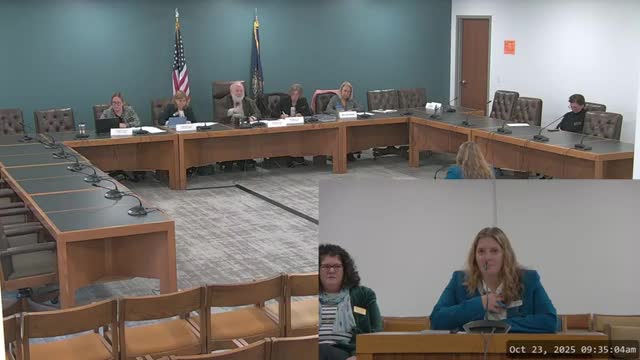Charter school leaders brief NH study committee on enrollment, funding and special-education arrangements
October 24, 2025 | Committee to Study Reducing the Number of School Administrative Units in the State, House of Representatives, Committees , Legislative, New Hampshire
This article was created by AI summarizing key points discussed. AI makes mistakes, so for full details and context, please refer to the video of the full meeting. Please report any errors so we can fix them. Report an error »

Adams told the committee, “There are 37 charter schools this year.” She said last year’s charter enrollment was 6,034 students and that “we're getting, $9,180 per pupil at this time total, and that's with adequacy aid and then the additional charter school grant.” Adams described three standard arrangements for special-education services: services provided on a charter campus by staff hired by the charter; staff hired by the sending traditional district and sent into the charter; or transporting the student to the district school when appropriate.
Committee members pressed presenters about operational details. Jessica Wachsman, dean of operations at Birches Academy Charter School in Salem, said there is a special-education adequacy that “I think this year, it's, like, $2,300 per student,” and clarified that that fund is paid to the sending district to provide services for students from that district even if the student attends a charter school. Wachsman said charter schools receive the per‑pupil adequacy payment and the charter grant but do not receive the extra special-education adequacy that the district receives to deliver those services.
Adams and other presenters explained how transportation is handled: districts must provide transportation if the student lives in that district and attends a charter within the same district; districts do not have to bus students who attend charters outside their home district. Presenters also said charter schools must fundraise for additional program needs; Wachsman estimated Birches’ average cost per student at about $12,000 and said Birches had approximately 340 students and a wait list of about 160.
Emily Whalen, director of Next Charter School in Derry, described a formal partnership with the Derry Cooperative School District that allowed the school to operate as a local option for students who did not thrive at Pinkerton Academy. Whalen said Next opened in 02/2013 and has grown from 30 students to roughly 80 and plans to expand to about 100. She said the district pays tuition to the charter under an MOU and that the charter also pays rent under a multi‑year lease for school space.
Presenters discussed governance and reporting: each charter is governed by its own board and must complete state reporting (for example, DOE forms such as the DOE-25) and state testing. Adams said charter schools appear as separate SAU entries in state reporting systems so that parents can compare individual charter schools by performance data.
Committee members and presenters also discussed staffing and benefits. Adams said charter schools must ensure at least 50% of staff meet certification or equivalent experience requirements; many charters rely on a mix of certified teachers and staff with three or more years’ experience in a subject area. Wachsman and other presenters said many charter schools do not participate in the New Hampshire retirement system and therefore may offer different benefits and lower salaries than traditional districts, which complicates recruitment and retention. Facilities and capital costs were identified as a major challenge; presenters cited use of tax-exempt bonds and local fundraising to buy or upgrade school buildings.
Why it matters: committee members said these operational details affect any discussion of consolidating SAUs because charters’ funding flows, governance and reporting arrangements change how services such as special education, transportation and screening are financed and delivered. Several members urged care in crafting any changes so they would not unintentionally shift costs or responsibilities without accompanying funding or implementation plans.
Presenters and committee members said they would provide follow-up materials and numbers (for example, tuition comparisons with local academies and precise per-student figures) for the committee to review before further decisions.
View the Full Meeting & All Its Details
This article offers just a summary. Unlock complete video, transcripts, and insights as a Founder Member.
30-day money-back guarantee

